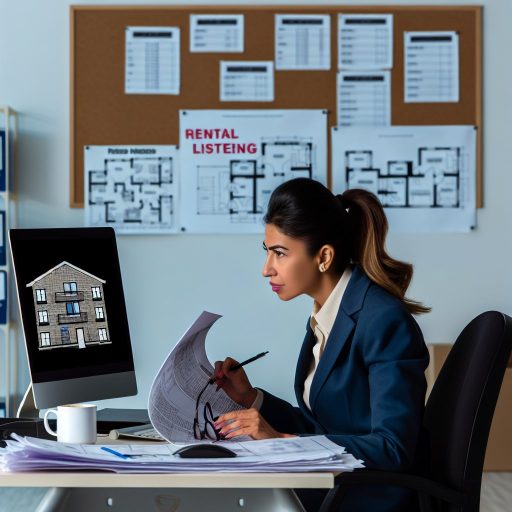Understanding the Importance of Property Inspections for Landlords
Ensuring Property Condition
Property inspections help assess the current condition of the rental property.
They enable landlords to identify issues early, minimizing repair costs.
Regular inspections can prevent small problems from escalating into major repairs.
Landlords should create a schedule for consistent inspections throughout the year.
This proactive approach enhances the property’s longevity and overall appeal.
Maintaining Tenant Satisfaction
Inspecting properties regularly helps ensure tenant safety and comfort.
Happy tenants are more likely to renew their leases, reducing turnover.
An inspection can also address any tenant concerns promptly.
Quickly resolving issues fosters a positive landlord-tenant relationship.
Legal Compliance and Liability Protection
Landlords have legal obligations to maintain safe rental properties.
Regular inspections can help landlords meet these legal standards effectively.
Documentation from inspections serves as evidence of due diligence.
Consequently, it protects landlords from potential legal issues.
Enhancing Property Value
Well-maintained properties tend to retain higher market value.
Regular inspections can provide insights into necessary upgrades or repairs.
Investing in improvements can attract better tenants and yield higher rents.
Ultimately, a property in good condition is a valuable asset for landlords.
Key Types of Inspections
Pre-Purchase Inspections
Pre-purchase inspections hold significant importance for first-time landlords.
These inspections provide a detailed assessment of a property’s condition.
Landlords can uncover hidden issues that may affect value.
Additionally, this inspection helps in making informed purchasing decisions.
Home inspectors evaluate structural integrity and systems.
It’s vital to check plumbing, electrical, and HVAC units.
Thus, being proactive early in the process saves money in the long run.
Routine Inspections
Routine inspections allow landlords to maintain their properties effectively.
Scheduling regular inspections promotes tenant satisfaction and property upkeep.
During these checks, landlords assess overall property condition.
They can identify wear and tear before it becomes problematic.
These inspections typically occur quarterly or biannually.
Furthermore, they help in keeping up with local ordinances.
Developing a consistent routine allows for better management practices.
Move-Out Inspections
Move-out inspections play a crucial role after a tenant vacates the property.
This type of inspection documents the property’s condition at departure.
Landlords compare the state of the property to the move-in inspection report.
If damage is found, landlords can charge tenants for repairs.
Proper documentation during move-out inspections helps prevent disputes.
It also aids in assessing the potential for future tenants.
Ultimately, these inspections ensure accountability and property preservation.
How to Choose a Qualified Inspector
Credentials to Consider
Look for inspectors with official certification in property inspection.
Many states require specific licenses for inspectors.
Additionally, check if they are members of professional associations.
Membership often indicates ongoing education and ethical standards.
Experience Matters
Ask potential inspectors about their years of experience.
A seasoned inspector can quickly identify underlying issues.
Moreover, experience with properties similar to yours is beneficial.
Inspectors specializing in residential or commercial buildings have different insights.
Reputation and Reviews
Research online reviews and testimonials from previous clients.
A good inspector will have a strong reputation in the community.
Check their website and social media for feedback and case studies.
Don’t hesitate to ask for references before making a decision.
Sample Inspection Reports
Request to see a sample inspection report.
The report should be detailed and easy to understand.
Look for clarity in how issues are documented and explained.
This indicates the inspector’s attention to detail and professionalism.
Cost Considerations
Get quotes from multiple inspectors to compare costs.
However, don’t choose solely based on price.
Low-cost inspections may overlook critical issues.
Focus on overall value rather than just the dollar amount.
Availability and Communication
Consider how quickly inspectors can schedule your property visit.
Good communication is essential throughout the inspection process.
Inquire about follow-up questions after receiving the report.
Choose someone who is responsive and willing to engage with you.
Delve into the Subject: Lease Agreements for Lease Renewal Negotiations
Common Issues Detected During Inspections
Structural Problems
Inspectors often find structural issues in properties.
Cracked foundations can indicate serious problems.
Additionally, sagging walls may suggest instability.
Look for signs of settling and bowing in the basement.
These issues can be costly to repair if not addressed early.
Plumbing Concerns
Plumbing inspections reveal common failures that landlords should know.
Leaky pipes often create hidden water damage.
Check for signs of corrosion on fixtures and fittings.
Water pressure should be sufficient throughout the property.
Furthermore, ensure that toilets flush properly and do not leak.
Electrical Issues
Electrical systems pose significant hazards if improperly installed.
Inspect for outdated wiring and overloaded circuits.
Check that outlets function and are grounded safely.
Inspectors also look for signs of electrical burns or damage.
Proper functioning electrical systems are crucial for tenant safety.
HVAC System Conditions
Heating, ventilation, and air conditioning systems require regular checks.
Inspect for proper airflow and unusual noises from units.
Both heating and cooling systems should operate efficiently.
Change filters regularly to ensure optimal performance.
Neglecting HVAC issues can lead to higher energy costs.
Exterior Maintenance
The exterior of a property influences its overall condition.
Inspect for missing shingles and signs of roof wear.
Check gutters and downspouts for clogs and leaks.
Cracked sidewalks may also pose risks to tenants.
Landscaping should be well-maintained to enhance curb appeal.
Interior Conditions
Inspectors examine the interior for various problems.
Look for evidence of mold or water damage on walls.
Verify that doors and windows open and close properly.
Inspect for signs of pest infestations like rodents or insects.
Paint and flooring should be in good condition for tenant comfort.
Learn More: Lease Agreements for Senior Living Communities
Preparing Your Property for an Inspection: Tips for First-Time Landlords
Understand the Importance of Inspections
Property inspections ensure your rental meets safety and health standards.
They protect you from liability issues down the road.
Additionally, inspections help identify maintenance needs before tenants move in.
Prepare Your Property Inside and Out
Start by assessing both the interior and exterior of your property.
Also, ensure landscaping is tidy and well-maintained.
Curb appeal is important for attracting quality tenants.
Furthermore, inspect the roof and gutters for any signs of damage.
Pay close attention to all entry points, including doors and windows.
Check Systems and Appliances
Test important systems, such as plumbing, electrical, and HVAC.
Make sure all appliances are working properly.
Replace any burnt-out light bulbs for better visibility.
Address Repairs Promptly
Identify and address any repair issues well before the inspection.
Fix leaky faucets, squeaky doors, and damaged flooring.
Additionally, patch up any holes in the walls for a neat appearance.
Organize Documentation and Records
Gather property documents, such as warranties and maintenance records.
Keep your rental agreement handy for reference.
Having all relevant documentation organized makes inspections smoother.
Communicate with Tenants
Notify your tenants well in advance about the upcoming inspection.
Encourage them to report any concerns or repair requests.
Clear communication fosters trust and cooperation during the inspection process.
Make a Final Walkthrough
Conduct a final walkthrough before the inspection date.
Look for any last-minute improvements or repairs needed.
Ensure the property is clean and clutter-free.
Finally, make a checklist to ensure nothing is overlooked.
You Might Also Like: Lease Agreements for Commercial Properties

Legal Obligations and Compliance
Understanding Local Inspection Laws
Property inspections are crucial for first-time landlords.
These inspections ensure compliance with local laws.
Understanding these laws protects landlords from legal issues.
Different regions have unique inspection requirements.
Research your local regulations thoroughly.
Neglecting inspections may result in hefty fines.
Types of Inspections
There are several types of property inspections to consider.
Initial or pre-rental inspections assess the property’s condition.
Routine inspections help maintain the property over time.
Move-out inspections check for damages once tenants leave.
Each type of inspection serves a specific purpose.
Scheduling Inspections
Schedule inspections at consistent intervals.
Clearly communicate the schedule to your tenants.
Give tenants advanced notice before any inspection.
This approach builds trust and cooperation.
Respecting tenant privacy is essential.
Record Keeping
Keep detailed records of all inspections conducted.
Include dates, findings, and any necessary actions.
Documentation can serve as evidence in disputes.
Store these records securely for easy access.
Hiring Professionals
Consider hiring certified inspectors for thorough evaluations.
They provide unbiased assessments of your property.
Professional inspections often uncover hidden issues.
Many landlords find this investment worthwhile.
Staying Informed
Regularly review local laws to stay compliant.
Laws can change, impacting your responsibilities.
Attend landlord workshops and seminars for updates.
Connect with local landlord associations for support.
Staying informed helps prevent future violations.
Gain More Insights: Understanding Tenant Rights and Landlord Obligations in Evictions
Creating a Property Inspection Checklist
Understanding the Importance of Inspections
Property inspections protect your investment as a landlord.
They help identify potential issues before they escalate.
Plus, regular inspections promote better tenant relationships.
Essential Areas to Inspect
Start by focusing on key areas of the property.
Each area requires thorough examination and consideration.
Exterior Inspection
First, assess the overall condition of the building’s exterior.
Check for cracks or damage to siding and foundation.
Also, inspect windows and doors for proper sealing.
Additionally, ensure the roof is not showing signs of wear.
Don’t forget to inspect the gutters for clogs or damage.
Interior Inspection
Next, move to the interior of the property.
Examine all rooms for cleanliness and maintenance.
Evaluate the condition of floors and walls for damage.
Moreover, check the functionality of appliances and fixtures.
Look into plumbing for leaks or water accumulation.
Safety Checks
Safety features are crucial for tenant safety.
Inspect smoke detectors and carbon monoxide alarms.
Also, check fire extinguishers are readily accessible.
Evaluate the condition of handrails and stairs for security.
Creating an Organized Checklist
Having a checklist streamlines the inspection process.
Use a digital format for easy updates and accessibility.
Include clear categories for each area of the property.
Prioritize items based on urgency and importance.
Documenting Findings
Document all findings during the inspection.
Take pictures of any issues you find.
This documentation will be crucial for repairs or disputes.
Use notes to schedule follow-up actions as needed.
Conducting Regular Inspections
Regular inspections promote a well-maintained property.
Schedule inspections periodically throughout the year.
This practice helps identify new issues promptly.
Also, regular check-ups instill confidence among tenants.
After the Inspection: Navigating Repairs and Tenant Communication
Understanding the Inspection Report
Review the inspection report carefully after receiving it from the inspector.
Identify the critical repairs required immediately.
Take note of minor repairs that may be addressed later.
Organize the issues based on urgency and importance.
Consult with a trusted contractor if the report outlines extensive repairs.
Creating a Repair Timeline
Draft a timeline for addressing the necessary repairs.
Prioritize critical repairs first to ensure tenant safety.
Communicate the timeline to potential tenants for transparency.
Set realistic deadlines to avoid overpromising on timelines.
Budgeting for Repairs
Estimate the costs involved for each repair identified.
Include contingencies in your budget for unexpected expenses.
Consider getting quotes from multiple contractors for competitive pricing.
Allocate funds accordingly to cover both urgent and minor repairs.
Communicating with Tenants
Establish clear communication with your tenants regarding repairs.
Inform them about ongoing repairs and expected completion dates.
Encourage feedback from tenants about their repair experiences.
Be responsive to tenant concerns or questions about repairs.
Managing Tenant Expectations
Set clear expectations about what repairs will be done and when.
Keep tenants updated on progress throughout the repair process.
Recognize that delays can occur, and communicate these swiftly.
Provide alternatives if repairs will impact tenant convenience significantly.
Finalizing Repairs and Follow-Up
Inspect completed repairs to ensure they meet quality standards.
Follow up with tenants after repairs to assess satisfaction.
Seek to build a good relationship by being approachable and available.
Document all repairs for future reference and potential issues.
Additional Resources
My landlord is coming to do an inspection tomorrow. Do we have to …




